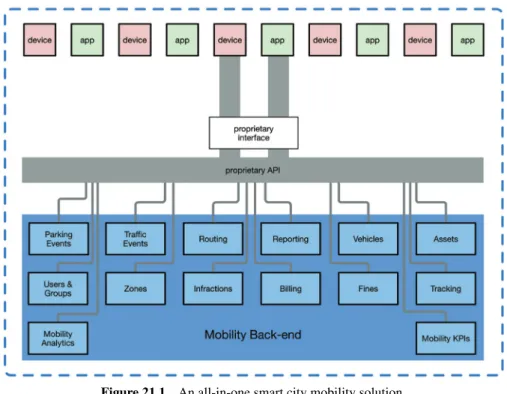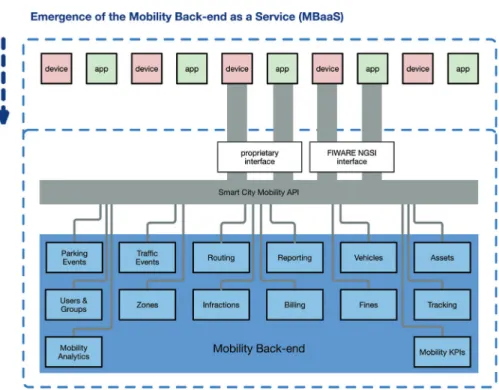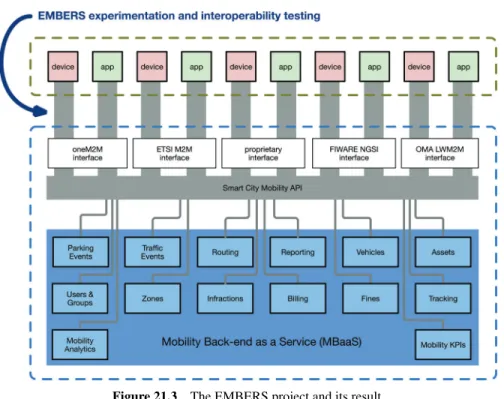HAL Id: hal-01571401
https://hal.sorbonne-universite.fr/hal-01571401
Submitted on 2 Aug 2017HAL is a multi-disciplinary open access archive for the deposit and dissemination of sci-entific research documents, whether they are pub-lished or not. The documents may come from teaching and research institutions in France or abroad, or from public or private research centers.
L’archive ouverte pluridisciplinaire HAL, est destinée au dépôt et à la diffusion de documents scientifiques de niveau recherche, publiés ou non, émanant des établissements d’enseignement et de recherche français ou étrangers, des laboratoires publics ou privés.
Enabling a Mobility Back-End as a Robust Service
(EMBERS)
Ricardo Vitorino, Margarida Campolargo, Timur Friedman
To cite this version:
Ricardo Vitorino, Margarida Campolargo, Timur Friedman. Enabling a Mobility Back-End as a Robust Service (EMBERS). Martin Serrano; Nikolaos Isaris; Hans Schaffers; John Domingue; Michael Boniface; Thanasis Korakis. Building the Future Internet through FIRE, River Publishers, pp.596-602, 2017, 978-87-93519-12-1. �10.13052/rp-9788793519114�. �hal-01571401�
21
Enabling a Mobility Back-End
as a Robust Service (EMBERS)
Ricardo Vitorino1, Margarida Campolargo1 and Timur Friedman2
1Ubiwhere, Portugal 2UPMC, France
Several cities in Europe have started to provide real-life models of what a smart urban environment should be, through their deployments of innovative, sustainable, and efficient technologies. For instance, Vienna (Austria) is a leader in the domain of electric vehicles, with more than 400 charging stations in its streets, while also developing an open bike sharing system and car-share programs. Another example is Grenoble (France), with thorough testing of its Toyota electric vehicles fleet, integrated as part of the municipal transportation infrastructure, understood as a multimodal system, in which trips smoothly integrate the use of electric vehicles and the public transportation network. Many other cities are following these examples, establishing their own systems, with a strong emphasis on smart city mobility. The first generation of smart city mobility solutions tends to be “all-in-one” packages provided by a single vendor, which possibly comprises a diverse range of elements, such as:
• Sensors on the street (for instance for parked vehicles and traffic) and gateways that receive sensors’ data via radio frequency communication and which pass the data on over fixed-line networks;
• A mobility back-end that receives and processes the data plus a management tool that controls the system;
• Information panels that display parking and traffic information in the city, apps that drivers use for navigation and for finding parking and websites that help guide users via the web.
596 Enabling a Mobility Back-End as a Robust Service (EMBERS)
The EMBERS project anticipates that a second generation of smart city tech-nology will evolve to an entirely different solution. Ubiwhere, the company that is at the heart of EMBERS, is a provider of smart city solutions through its Citibrain brand, which realises that city managers, rightly, no longer wish to purchase single turnkey solutions. They would like to avoid locking their municipalities into a single vendor and become completely dependent upon that vendor for all of the system’s components and maintenance. The same is true for urban mobility providers looking to upgrade their systems to a smart city ecosystem. As system assemblers, they seek the possibility to compose a multi-faceted system from multiple vendors, each one of which provides the best-of-breed component for the particular application domain that it serves.
With the purpose of allowing a municipality, or a system assembler working under contract, to put a set of diverse elements together into a single coherent system, each part must follow a common specification for interoperability, including, for instance, an open standard set of Application Programming Interfaces (APIs). With open specifications, the integration of third-party urban furniture, applications and other digital systems becomes an uncomplicated chore. Hence, cities are jumping at the possibility of more open systems, as exemplified by the Open & Agile Smart Cities initiative, in which 89 municipalities from 19 countries in Europe, Latin America and Asia-Pacific are adopting FIWARE’s version of the Open Mobile Alliance’s Next Generation Service Interfaces (OMA NGSI). By providing generic ways for a client and server to interact and change their state, the APIs that municipalities are embracing today mark an essential first step towards facilitating open data exchange. They are designed to promote interoperability across a full range of Internet of Things (IoT) devices, apps, and servers, but without going into individual application domains. The project’s platform will go the next step by providing a free and open API that is specific for smart city mobility. It will allow developers of devices and apps to start immediately exchanging information about vehicles, roads, routes, parking spaces, drivers, and so forth, without having to reinvent this vocabulary and its rules or follow a closed, proprietary system.
EMBERS’ first goal is to transform the Citibrain’s platform into a market-ready solution. It is entirely more challenging to try to achieve interoperability with multiple third-party devices and applications by offering the platform via an open, public, mobilityAPI for smart cities than to run it inside one’s personal system, integrated with components developed by oneself, via a proprietary interface.
Much of EMBERS’ effort is devoted to subjecting the solution to rigorous and extensive testing on FIRE+ testbeds to ensure its robustness. These testbeds are the FUSECO Playground, which offers a machine-to-machine (M2M) experimentation environment, and the FIT IoT-LAB facility, which allows testing with large numbers of sensor devices. While the first testbed has been used to test the machine-to-machine (M2M) interactions, the latter has been applied to test interactions of the solution with many different Internet of Things (IoT) devices.
EMBERS also aims at inviting designers of applications and devices to develop their interfaces to work with the smart city mobility API. Ubiwhere will offer this domain-specific interface via a full suite of lower-level APIs, to ensure the widest possible freedom of choice at a time when no single specifica-tion has emerged as a dominant standard. Participaspecifica-tion will be encouraged both through hackathons and through an app contest, each offering prizes to the best entrants. Furthermore, three developers will receive funding via an open call, which will allow them to experiment with their applications in the same FIRE+ testing environments using the EMBERS platform. These activities focused on building third-party engagement intend to achieve EMBERS’ second goal: to stimulate the smart city mobility ecosystem in Europe.
Finally, EMBERS third goal is to contribute back to FIRE+, by enhancing the experimentation capabilities of two of its principal facilities by the lessons learned. Furthermore, EMBERS will provide a valuable use case for efficient work with enterprises, which in turn is expected to motivate further usage in the future.
As referred before, municipalities are seeking alternatives to “all-in-one” closed smart city mobility systems, as they would like to be able to compose a system from multiple suppliers. With the possibility of combining the best-of-breed components from competing suppliers, city councils can serve better the interests of the citizens and the municipality. The key to enabling such freedom of choice is to choose systems that offer a set of standard and open APIs, which will allow the integration of multiple components.
In this context, EMBERS focuses on one central element, with which all of the other modules must operate: the mobility back-end, developed by the company Ubiwhere as a stand-alone product. In EMBERS, the deployment and testing in a set of varied scenarios using the FIRE+ facilities (FUSECO Playground and FIT IoT-LAB) will enable Ubiwhere to make critical design decisions about the product. Through dissemination events, such as the app challenge, hackathons, and ultimately an open call, EMBERS will bring in
598 Enabling a Mobility Back-End as a Robust Service (EMBERS)
other companies that offer products in the smart city mobility field, allowing them to test the interoperability of their components against these same APIs and scenarios. In addition to helping the project’s lead user, Ubiwhere, to move its product towards the market, EMBERS aims at transforming the smart city mobility ecosystem in Europe.
Three diagrams illustrate the overall concept: Figure 21.1 shows a fully integrated system of the most common type nowadays; Figure 21.2 shows the initial state of development of the system that EMBERS tests and Figure 21.3 illustrates the system as it will be at the end of the project.
In all three figures, there are devices and applications at the top and the mobility back-end at the bottom, which consists of a set of modules that handle all different aspects related to mobility in smart cities. The Parking Events module, for instance, tracks the occupancy of parking spaces and devices, such as road sensors, providing information to the module about vehicles arriving and leaving. An application might draw upon the module to inform users about the locations of available parking spaces and, similarly, devices such as
Figure 21.2 Positioning at the start of the EMBERS project.
roadside information panels can receive such data, supplied by applications as the identities of vehicles and their drivers. These exchanges take place via a domain-specific API, shown in grey, with each module providing a small part of the overall API. During Ubiwhere’s first development of Citibrain’s Smart Parking and Smart Traffic Management products, the domain-specific API was purely proprietary, just like the interface by which devices and apps connected to the back-end (shown in Figure 21.1 as a white box, above the domain-specific API). The dashed line around the entire system (see Figure 21.2) represents the product marketed, which is an “all-in-one” solution.
Figure 21.2 shows the changes devised and implemented as Ubiwhere prepared to break out the platform as a separate component. At this stage, the smart city mobility API became designed for external developers, structured around hardware and software development kits (SDKs). Alongside with the initial proprietary interface, a set of FIWARE core components is introduced, so that any devices or apps created for this interface can interact with the back-end in a standardised way. The aim, as shown by the dashed arrow, is to push down the boundary of the product (the dashed line), so that it no longer
600 Enabling a Mobility Back-End as a Robust Service (EMBERS)
Figure 21.3 The EMBERS project and its result.
encompasses the devices and applications. In Figure 21.3, the work required from the EMBERS project can be better understood.
Alongside with FIWARE NGSI and Ubiwhere’s proprietary interface, other generic interfaces will be available: oneM2M, ETSI M2M, and OMA LwM2M, as it is too early to tell which of these interfaces (if any) will ultimately emerge as a de facto standard. The EMBERS purpose is to lower the barriers to entry to the device and app developers’ community (some of the developers may be writing to a specific type of interface while others support another interface) and, as such, the domain-specific smart city mobility API will be made available to them. Moreover, thanks to the FIRE+ testbeds, experimentation and interoperability testing will take place on the interactions between devices/apps and the platform, i.e. the interface between the two clearly separated boundaries.
With the hackathons, the app challenge, the open call experiments, and with some real-world pilots, such a platform, fully separated as a product, from the devices and apps, yet interacting with them via well-defined APIs, is perceived to be ready to market.
EMBERS will set up a federated M2M/IoT testing and experimentation infrastructure, based on the two FIRE+ testbeds that fit particularly well to this purpose: the FUSECO Playground in Germany, and FIT IoT-LAB in France. The first phase involves interconnecting the testbeds and enabling cross-domain testbed resource management (including user authentication, authorization, resource discovery, provisioning) and cross-domain experimen-tation (including experiment control and cross-domain monitoring) utilising the current standard FIRE+ tools and interfaces, such as FITeagle, MySlice, SFA, OMF, and OML. Afterwards, a standards-based (ETSI M2M, oneM2M) M2M platform, OpenMTC, is integrated into the federated infrastructure and the FIRE+ tools, mentioned above, for M2M/IoT resource manage-ment and experimanage-mentation. Setting up the core systems for testing allows the subsequent integration of Ubiwhere’s Mobility Back-end as a Service into EMBERS’ IoT/M2M test infrastructure. At this point, standards-based sensor/actuator communication (i.e., either via WebSockets, COAP, MQTT, RESTful interfaces) with the M2M/IoT platform, as well as standards-based interoperability between platform APIs and M2M/IoT applications (on top) is provided. Various sensor technologies, a) already existing in the two FIRE+ testbeds, b) provided by Ubiwhere, and c) provided by third party application developers or experimenters, are integrated into the EMBERS M2M/IoT experimentation environment. The whole physical infrastructure (including sensors and actuators), FIRE+ federation systems, and services for testing and resource management, M2M/IoT platform (OpenMTC integrated with Ubiwhere’s MBaaS) becomes available for designing and scripting tests targeted at maturing and benchmarking the platform, repeatedly executed in different scenarios. Experiences and encountered issues while conducting end-to-end tests on EMBERS will be fed back to the M2M/IoT experimentation platform developers and used to improve the EMBERS facility, before, in the next phase, in the hackathon, app contest, and the open call, tests are being executed by third parties on top of the EMBERs M2M/IoT experimentation facility.
As for the city pilots, Ubiwhere will take the results of the experimentation in FIRE+ testbeds and translate them into a real life environment. Existing and new sensors for parking and traffic management will be deployed and integrated with the new version of the Mobility Platform. Ubiwhere will work with municipalities, local universities and innovation hubs to engage third parties who wish to create new applications for their cities, based on the capabilities at hand. Ubiwhere is also taking on the task of integrating
602 Enabling a Mobility Back-End as a Robust Service (EMBERS)
transportation open and linked data from these regions to facilitate app development. Results of the pilots will be monitored, measured and validated against those collected in controlled FIRE+ infrastructure (and those obtained before the start of the project) so that the company and FIRE+ testbed owners can understand how the experimentation period allowed Ubiwhere to improve its product and increase its Technological Readiness Level (TRL).


